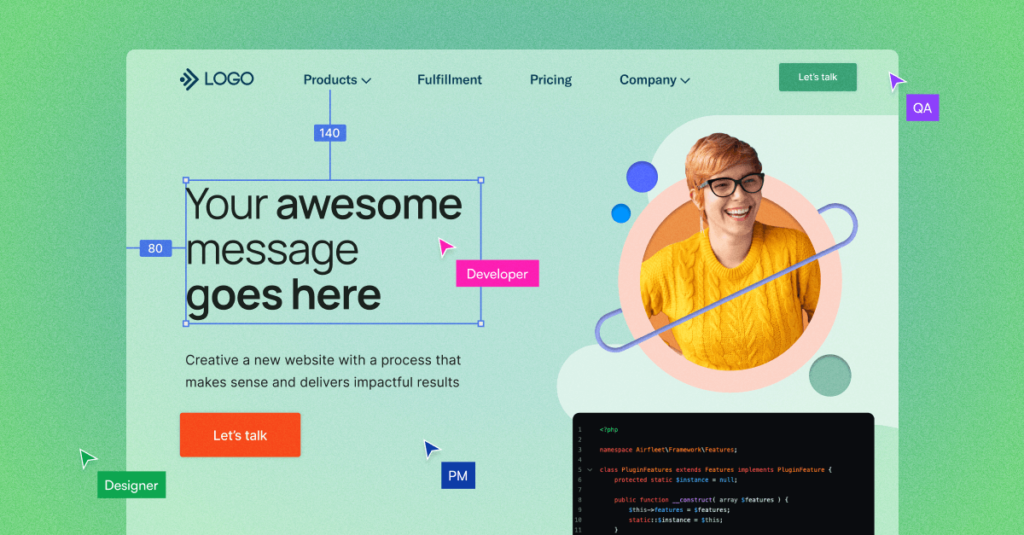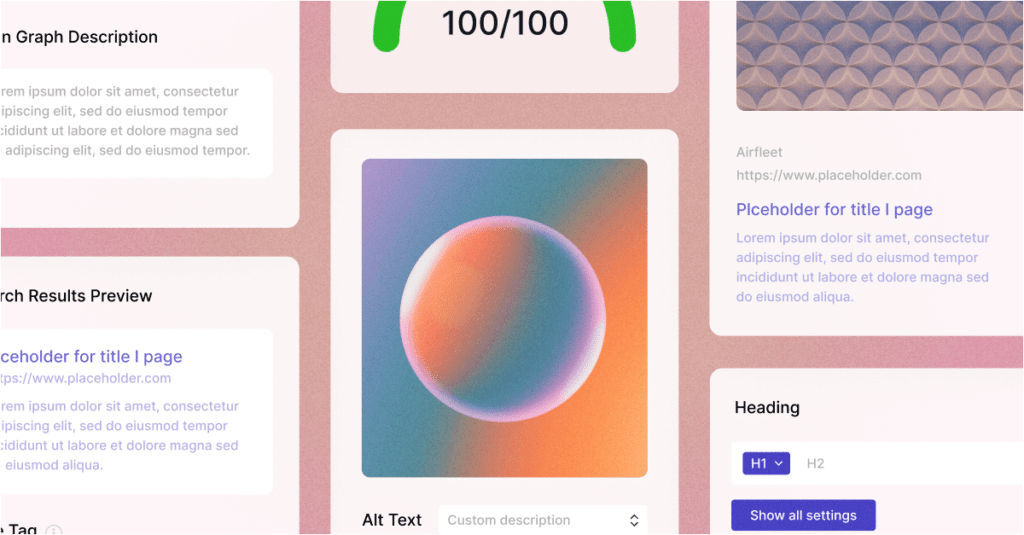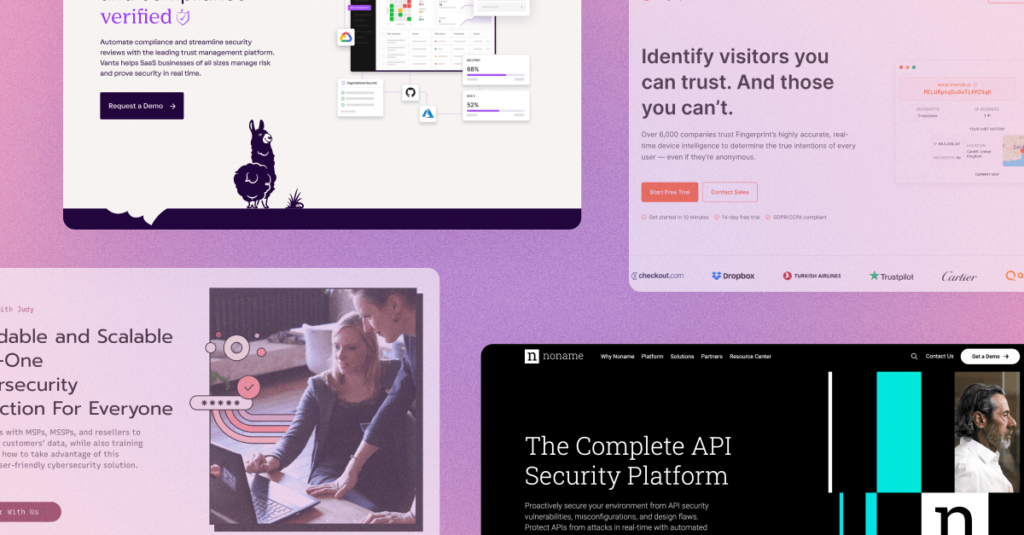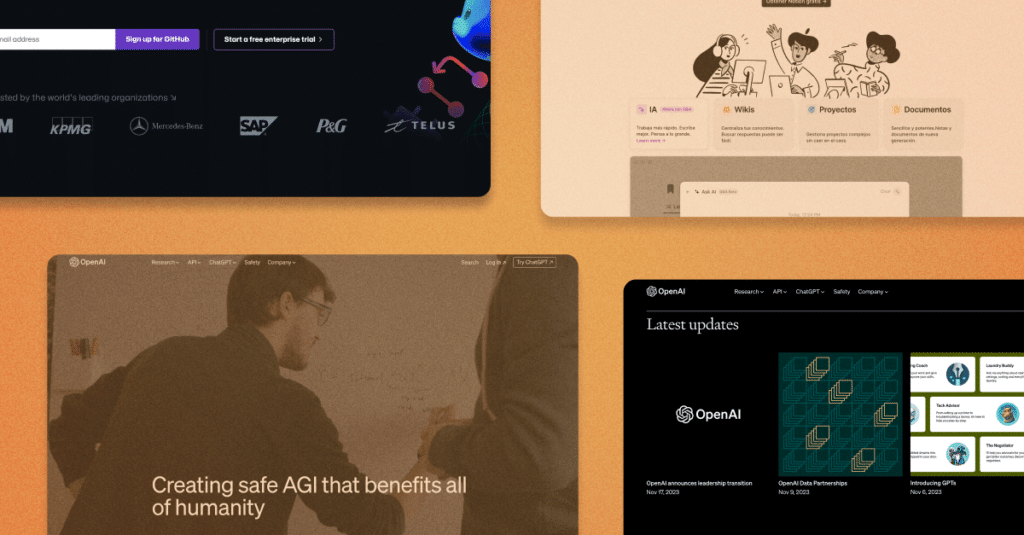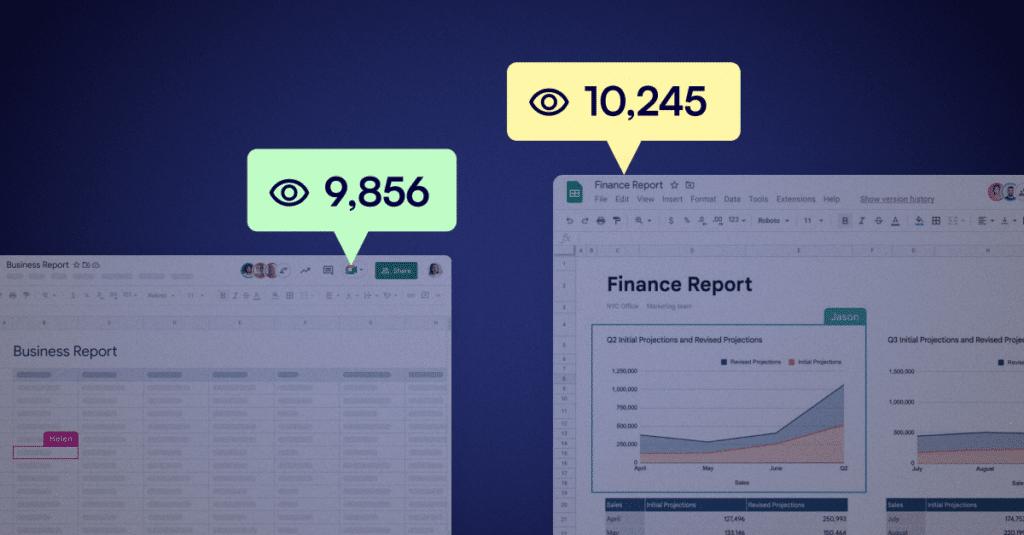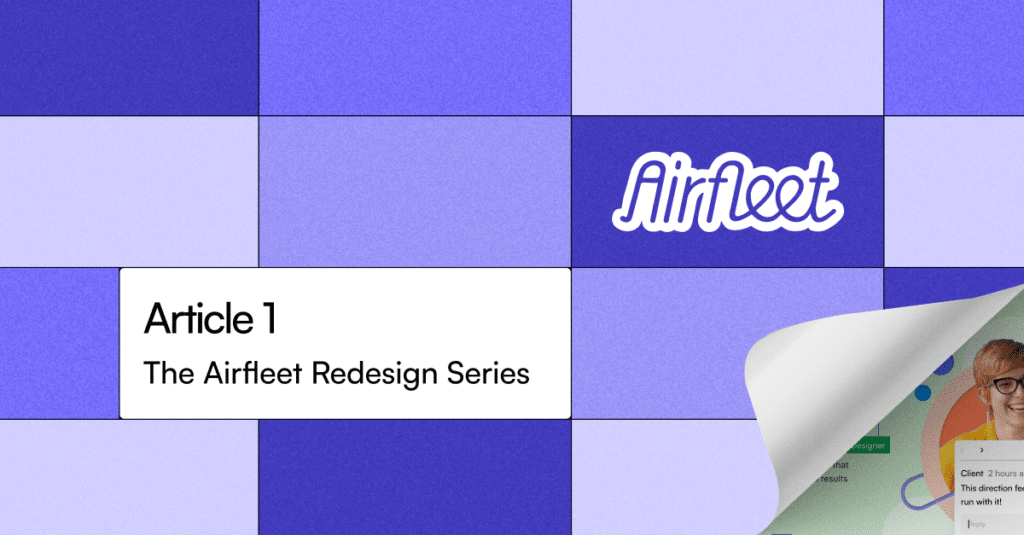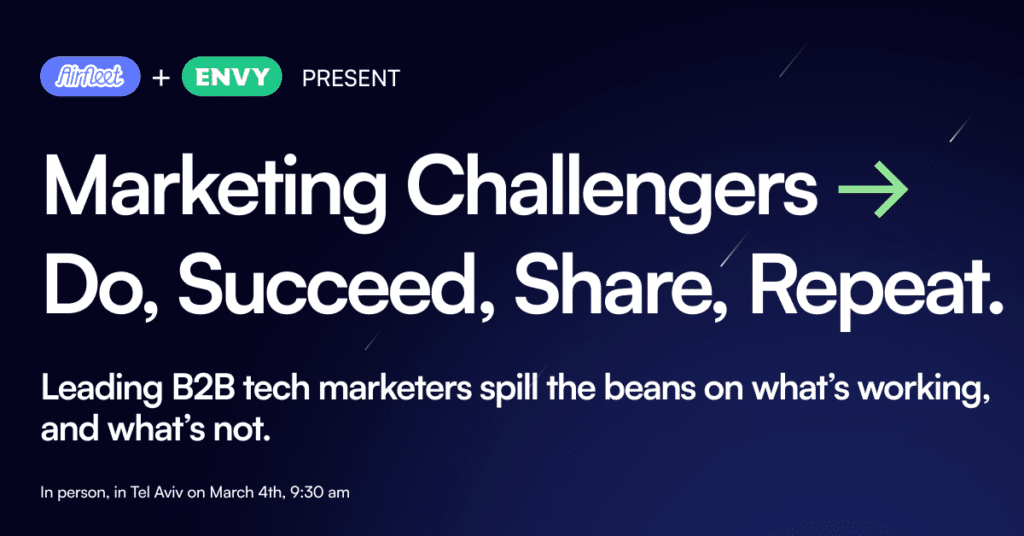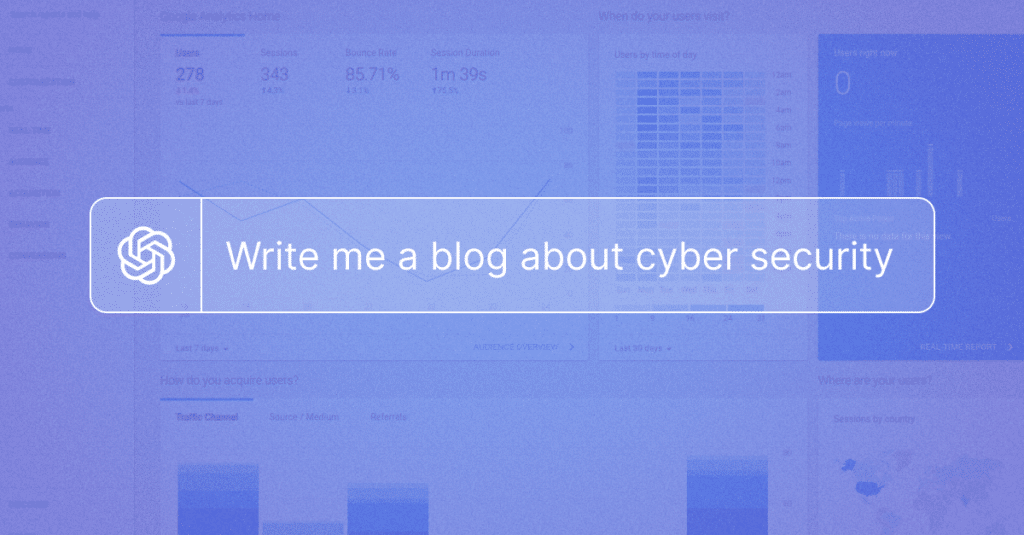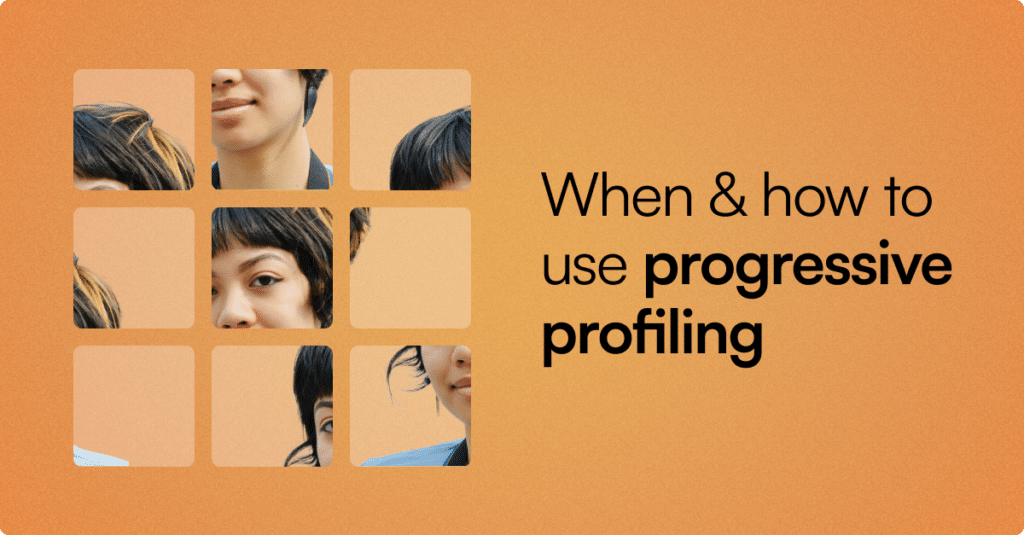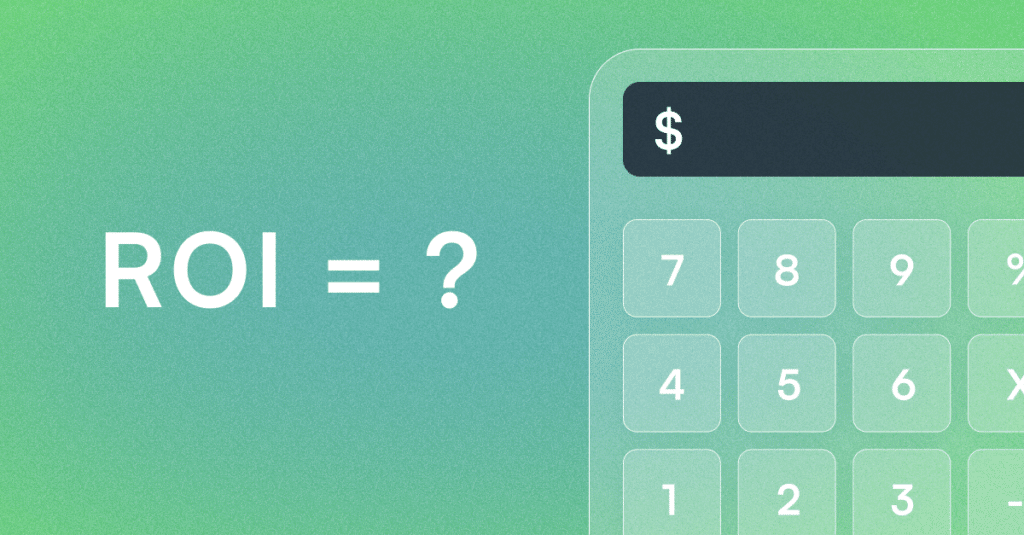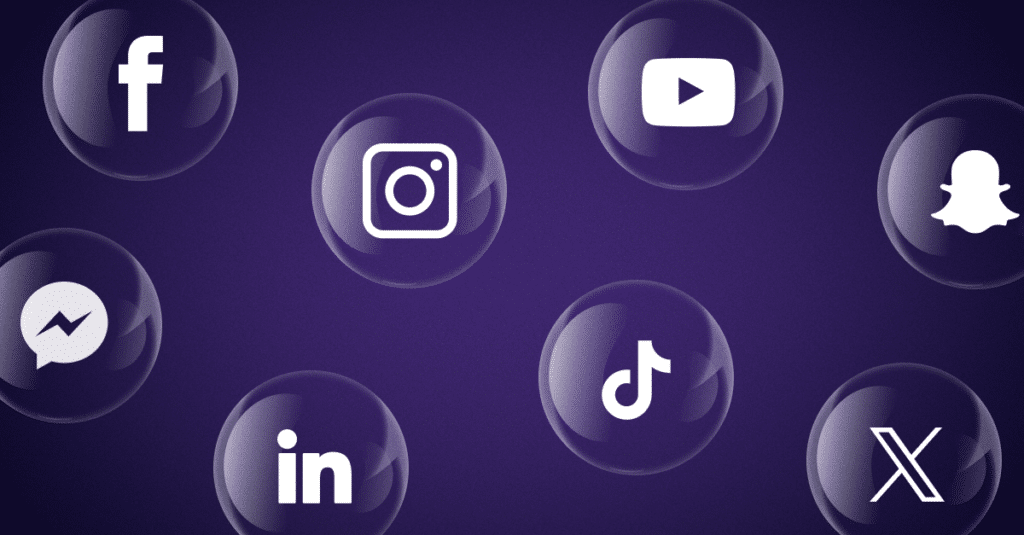12 Nurturing Campaigns Done Right – by Top Companies in the Tech Marketing Industry
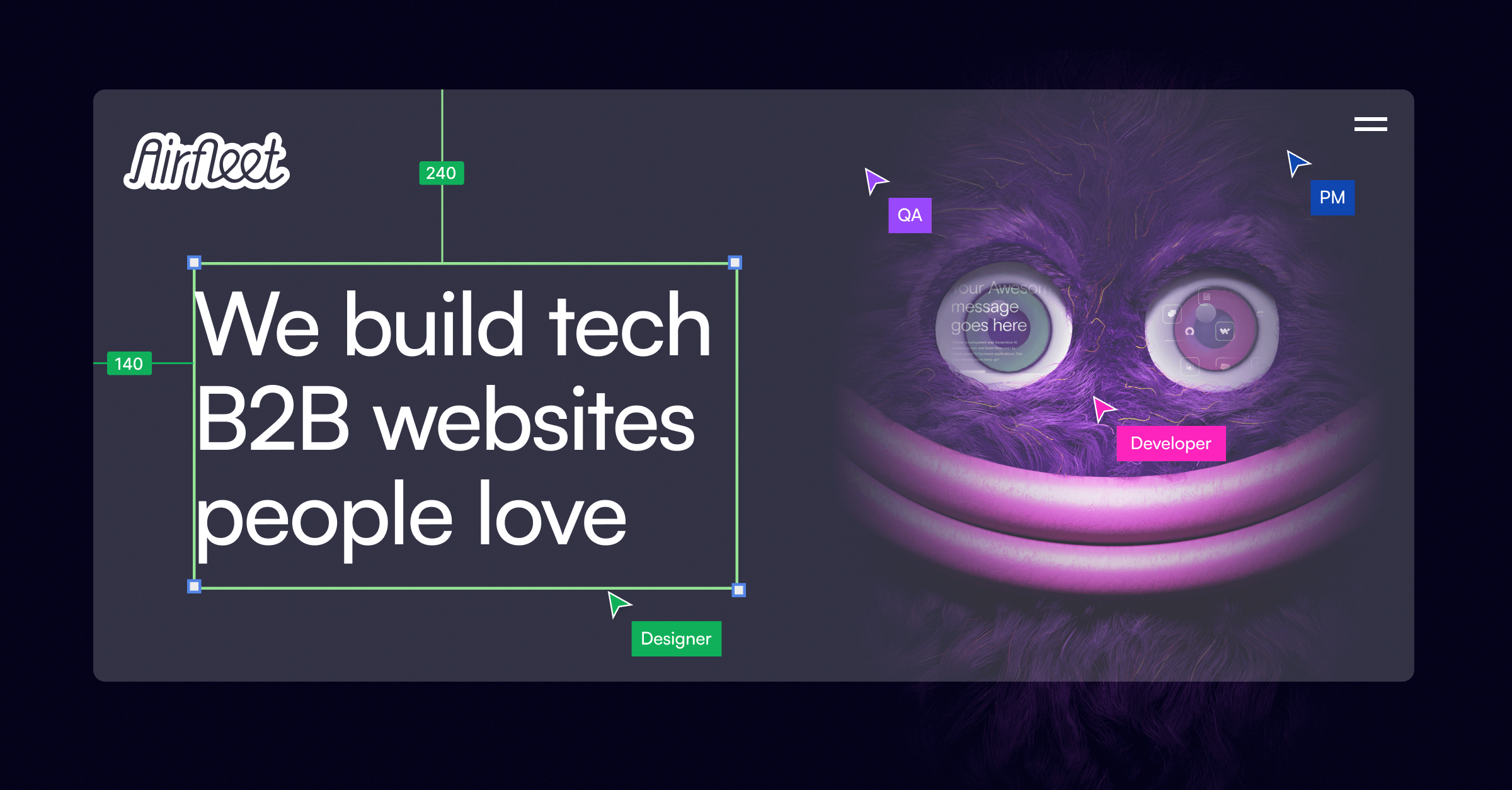
If you’re in B2B marketing, especially in demand/lead generation you’re probably familiar with nurturing campaigns.
We were trying to discover the magic of creating effective email nurture campaigns and decided to share what we discovered.
For almost 4 weeks, we took the role of a customer, engaging with different brands, aiming to understand how top companies are doing nurture campaigns. In this post we will share the 12 nurturing campaigns done right by top companies in the marketing industry such as HubSpot, Marketo, Taboola, Intercom and more.
Why is Lead Nurturing Important?
Lead nurturing is the process of building relationships with your leads at every stage of their buyer’s journey to make sure they proceed to the next step of the journey and engage with your brand.
Nurturing campaigns are also an opportunity to build trust, educate and scale the way you communicate with your potential and existing customers.
If you want a tl;dr – an effective nurturing will always aim to provide value for the customer, be tailor made for the customer based on journey stage, behavior, industry and previous actions. Each email must be personal and relevant with a clear agenda.
If you want to see how to do that, keep reading…
Our favorite 12 Lead Nurturing Campaigns
So, who would be better at creating nurturing campaigns than marketers, marketing to marketers? The companies listed here are martech products targeting marketers.
We’re happy to share with you our favorite nurture campaigns that we have experienced as leads being nurtured over the course of a 3 weeks period.
1. HubSpot
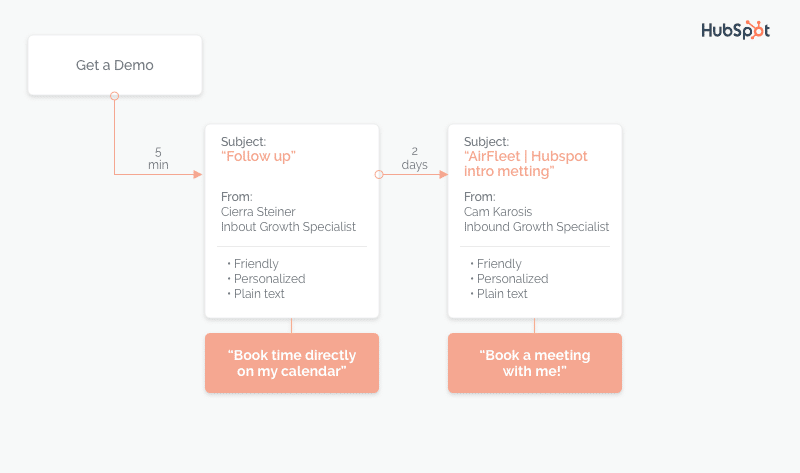
If you’re tracking your request a demo or schedule a meeting form submissions you’ve probably noticed that a lot of the submissions either aren’t converting to a MQL, or just never take another action.
HubSpot used great copy and personal touch in their response email to make sure you’ll be left with a feeling that there are real people on the other side, looking to chat with you and that you can personally engage with.
Email #1
The copy is simple, short and informal. The call to action is clear, note how the email invites you to a conversation – shoot me an email, call me, all of these different options to get in touch shows you they are trying to make your life easy.
Adding an image to your signature can do wonders, it makes the email feel personal and conversational when you see the other person’s face.
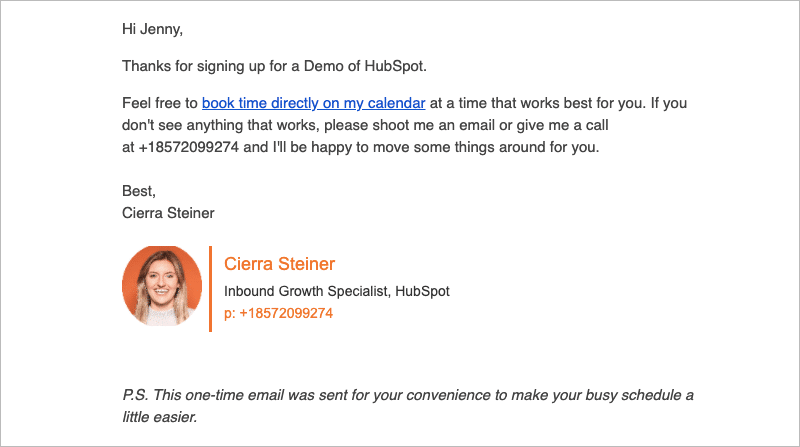
“Personalize your voice and keep it short. The lead should be able to glance at your email and, within five seconds, know the value it provides to them.” – eBook | HubSpot
Email #2
This time the value is clearly communicated – help evaluate HubSpot’s platform.
Again – invite to reply to the email with an addition of a two CTAs to schedule a call (including an ALL CAPS link and a big in your face button).
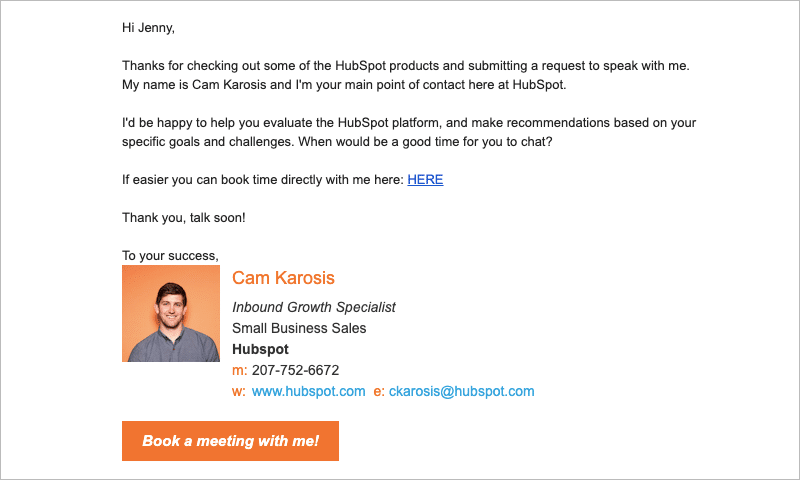
2. Drift
Drift is a conversational marketing and sales platform.
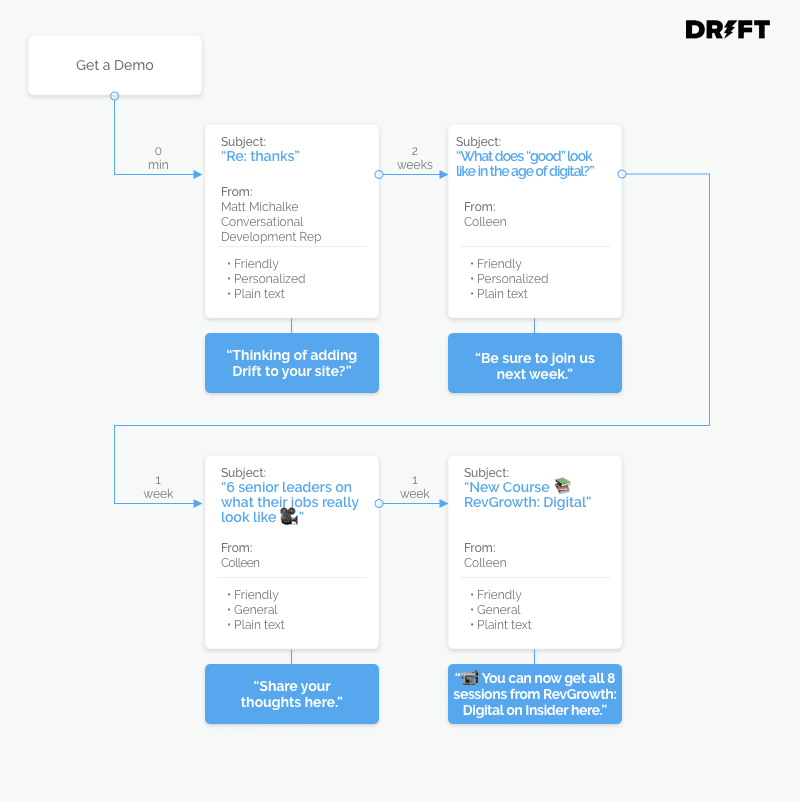
“It’s not to say that CTA’s and buttons don’t work, but there is always a better feeling in knowing that you’re speaking to a human being from the start. We see that conversational marketing provides a significant impact on the conversion rate.”
– Bonnie Seaman | Marketing Operations Manager @ AppsFlyer
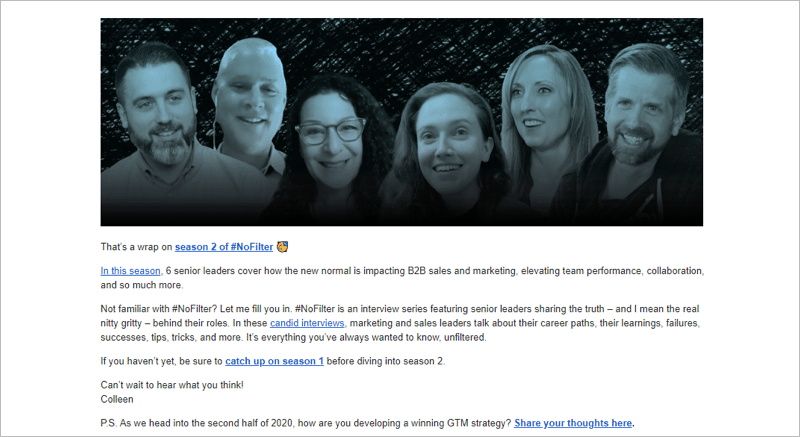
“Emojis are a part of Drift’s brand voice and will always be included in our emails. They draw the eye to specific CTAs and pull the reader to certain parts of an email. When we write our emails, we think about it as how we would use emojis when texting a friend. We try to keep all of our communication as human as possible“
– Matilda Miglio | Marketing Manager @ Drift
When you’re writing your copy, understand who your audience is and speak to them in their tone.
While every audience is a bit different, they all have one thing in common – they are all human (I hope)!
Drift makes it conversational, making every email feel like you’re emailing a friend.
3. Marketo
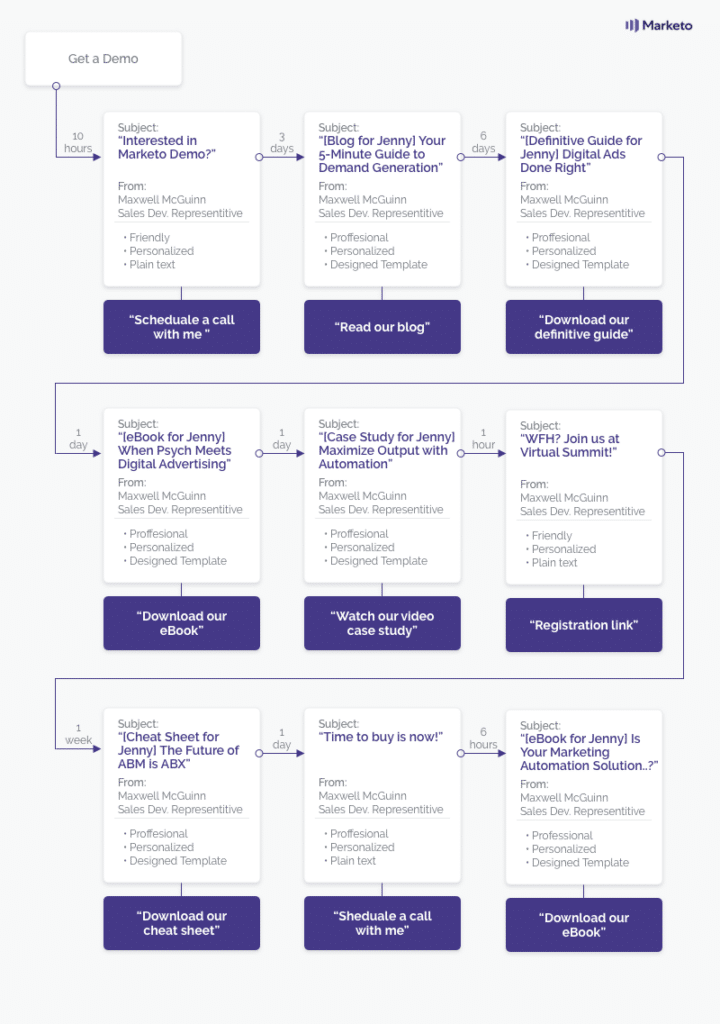
Ok, no
w this is getting serious. Marketo really took it to the next level when trying to provide value, educate their customers and personalize their emails.
Using the first name token in the email subjects makes them more inviting and personal, aiming to increase the open rate.
The first email I received after requesting a demo started with “Hi again”. The idea of us already being in touch and knowing each other makes me keep reading. Then, an open question inviting me to start a conversation about the best time to schedule a meeting, or, alternatively a link to schedule a meeting directly. Short, informal, to the point.
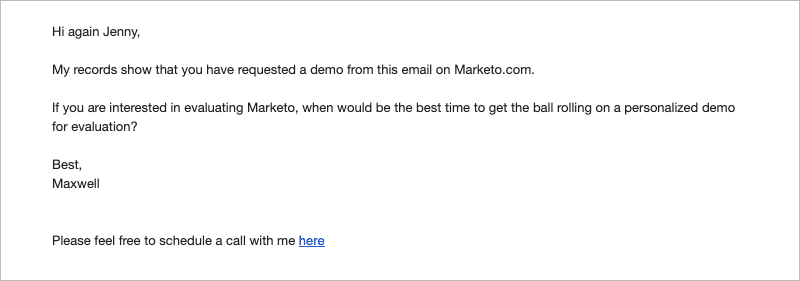
The second tactic Marketo uses is providing value by sharing premium content.
Providing beneficial content and resources that can help your contacts grow their business (such as eBook, case study, cheat sheet etc.) can help you build trust and create relationships with them.
Note the different design, the brand logo and colors to make sure I’ll relate to the company when consuming the resource.
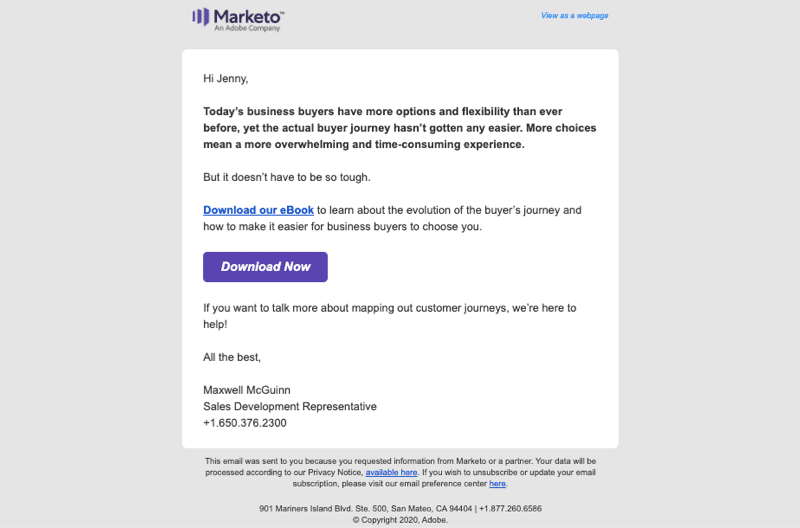
4. Taboola
Taboola is the world’s leading discovery platform. They recommend content and products from over 20,000 companies on premium websites to consumers across the globe.
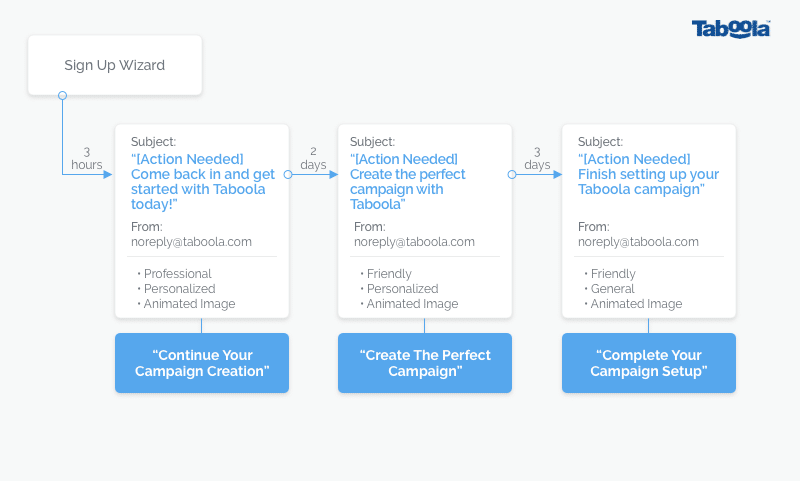
While the goal of most emails is to start conversations with your contacts, Taboola decided that in some cases, such as thank you and confirmation emails, to use a “no-reply” sender. And this is simply the message they want to convey – ”there’s no reason to reply to this email”. Make sense, right?
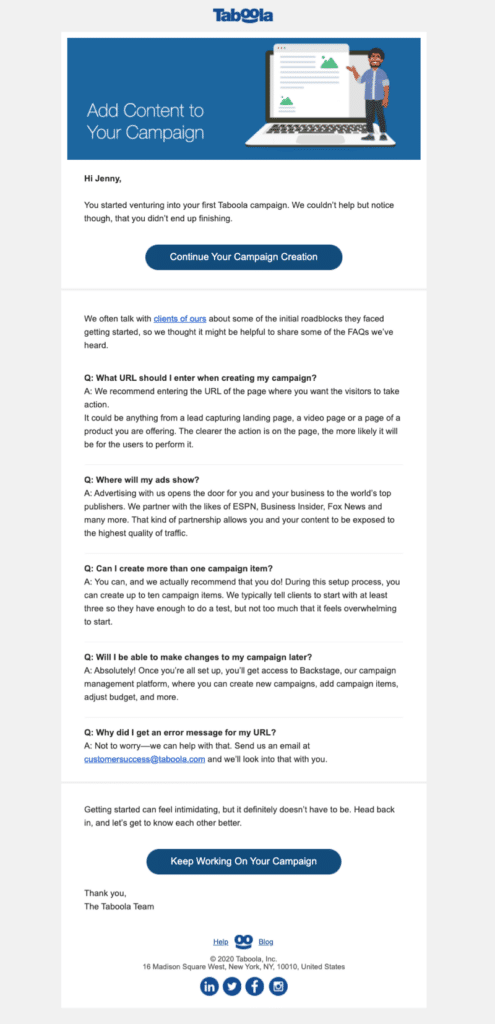
The decision on which content to share should be specific to each customer – where they are at the buyer’s journey, what actions they took on the site and the information you have about them.
This email is a good example of showing top of the funnel content when someone is high in the funnel. Help your customers boost their business by providing them with valuable information in the form of webinar, trends report, white paper etc.
When your audience is at mid/bottom of the funnel, the content should change and focus on product benefits and on your company differentiators with CTAs relevant to getting started / make a purchase / schedule a meeting with sales.
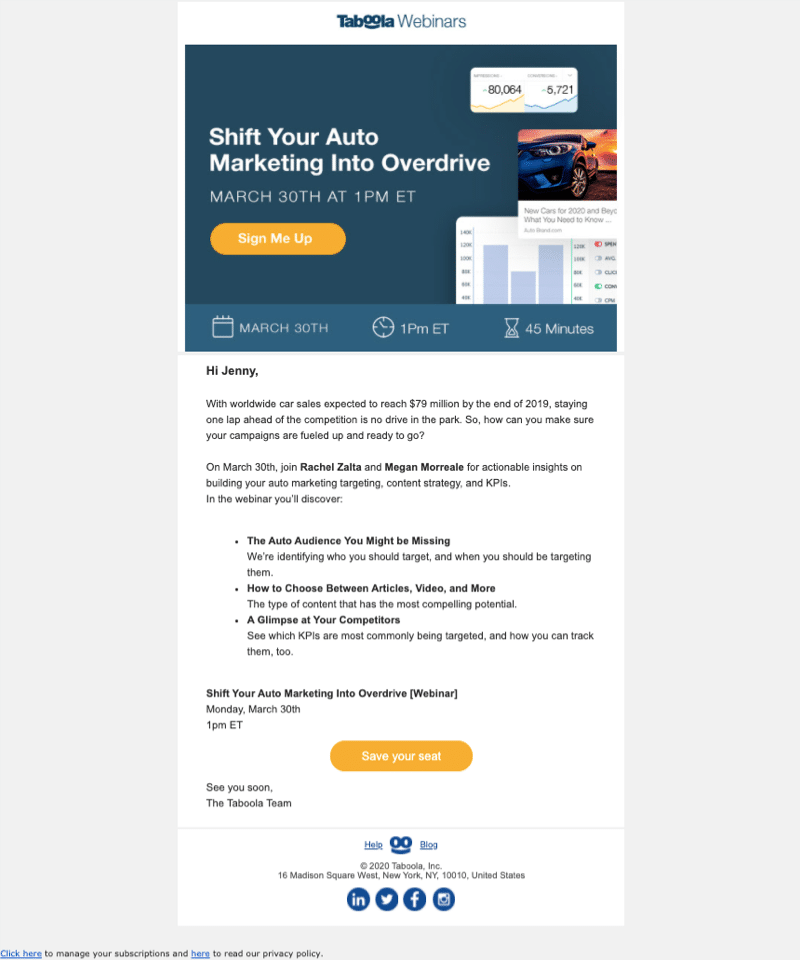
5. Hootsuite
Hootsuite is a social media management platform. It helps you keep track and manage your many social network channels. It can enable you to monitor what people are saying about your brand and help you respond instantly.
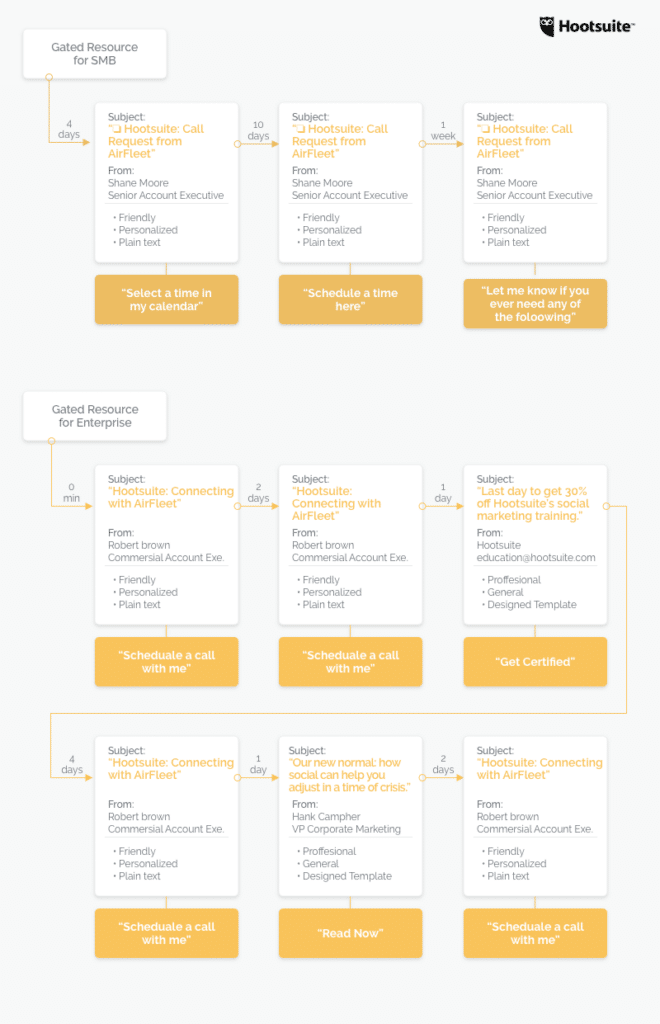
We’ve tested two segments, leading to separate paths in the email nurturing (always a good idea).
Seems like Hootsuite decided on different nurturing strategies for SMB vs Enterprise leads, which clearly demonstrates they’re more focused on targeting enterprise companies.
This is a great example of how you focus on your main target audience, while keeping in mind other potential customers.
Small / Medium Businesses
The SMB contact was approached with a friendly tone and received less emails with lower frequency.
Checkout how “easy” the copy is, not pushy at all, while trying to engage with a conversation. Adding a CTA in the signature linking to a content, makes it possible to continue the journey even if the customer isn’t ready for a conversation right now.
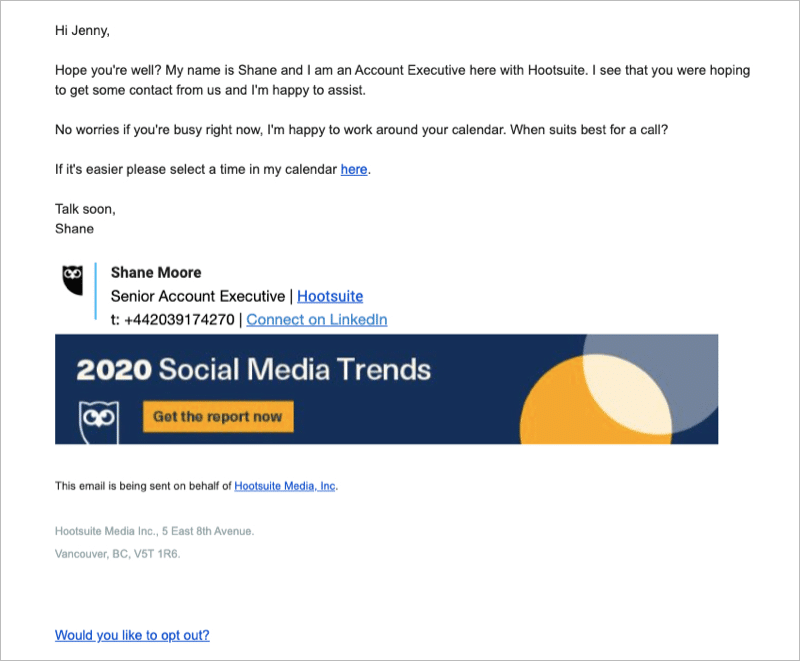
Enterprises
This contact was approached with a formal tone and received twice more emails at higher frequency. You can see how the email mentions the actions taken by the customer.
I personally relate to the offering to learn more about the customer and offer advice, the rule of reciprocity always works.
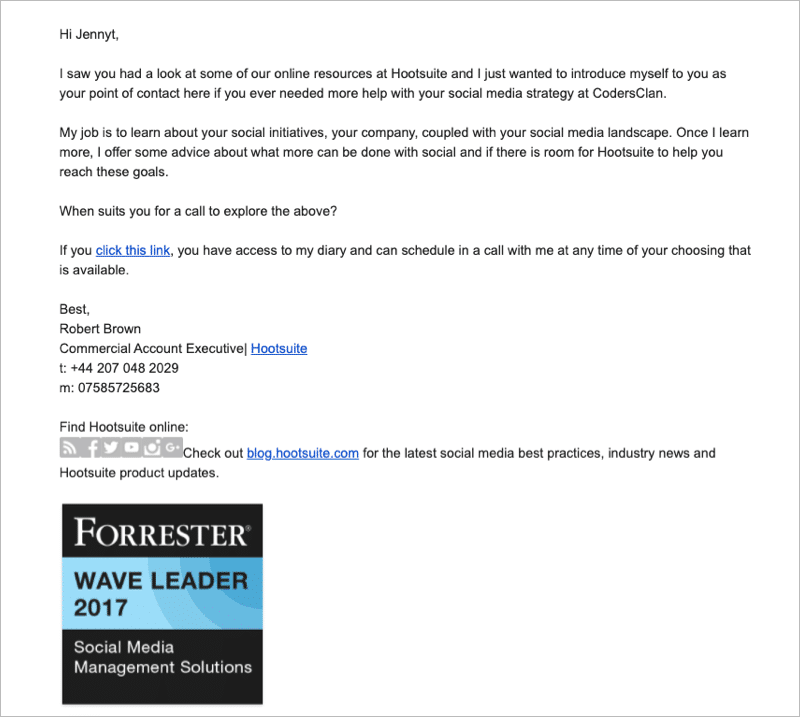
Not sure how to decide when to use a professional tone and when to use a friendly tone?
“Use both. In Taboola we have a copy guide book on how Taboola, as a company, should reach out to users and prospects. My mantra on this topic is that at the end of the day we are all human, and the key is in conveying the value to the customer in the way that is most appealing to them, which can be either professional or friendly – it really depends on the person you’re talking to. In Israel, we use the term ‘Sport Elegant‘. ”
– Guido Senderowitsch | User Engagement Lead @ Taboola
6. VWO
VWO is a comprehensive A/B testing and conversion optimization solution that provides you with a unified view of individual visitors to your site.
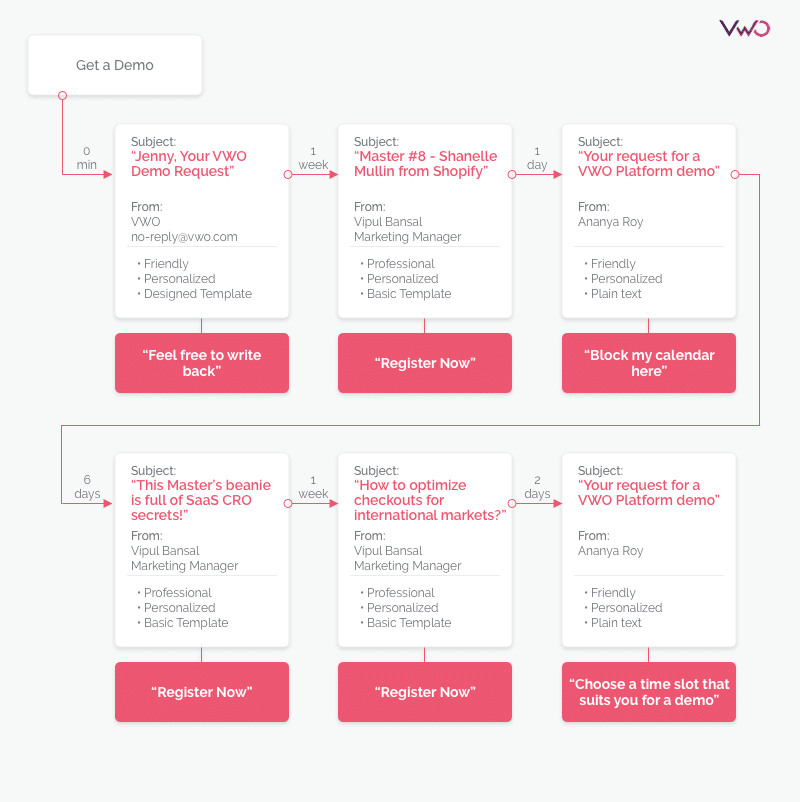
Continually receiving emails from two contacts in turns, almost felt like I was participating in two nurture campaigns.
The emails from Ananya were conversational, had a personal touch and used plain text only. These emails were related to me requesting a demo.
Note the structure – easy to read, short sentences, a lot of white space, opening and closing with the calendar CTA and the use of bold text for how VWO can help me.
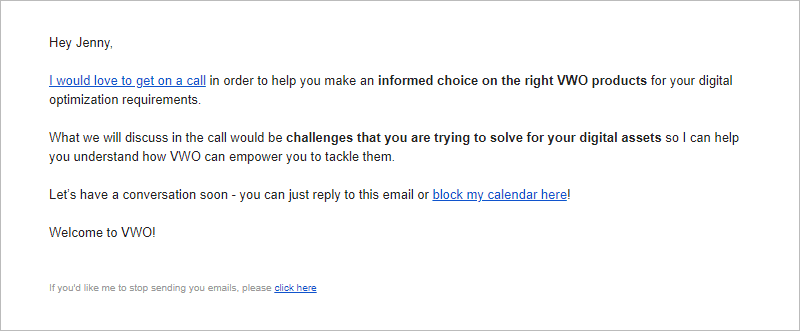
“The more you can personalize for each lead, the greater the success your nurture campaign will be. Use every piece of information you have on the lead to tailor a nurture experience that is unique to that person’s needs. Use different text that is specifically relating to the industry of the lead, as well as different language tones that fit the audience ie. different departments or certain job titles, such as CEO or developer etc.”
– Bonnie Seaman | Marketing Operations Manager @ AppsFlyer
The emails from Vipul were promoting beneficial content such as masterclasses and used a basic template. Just in case I wasn’t ready for a demo with Ananya, the emails from Vipul were making sure I educate myself and making progress in the buyer journey.
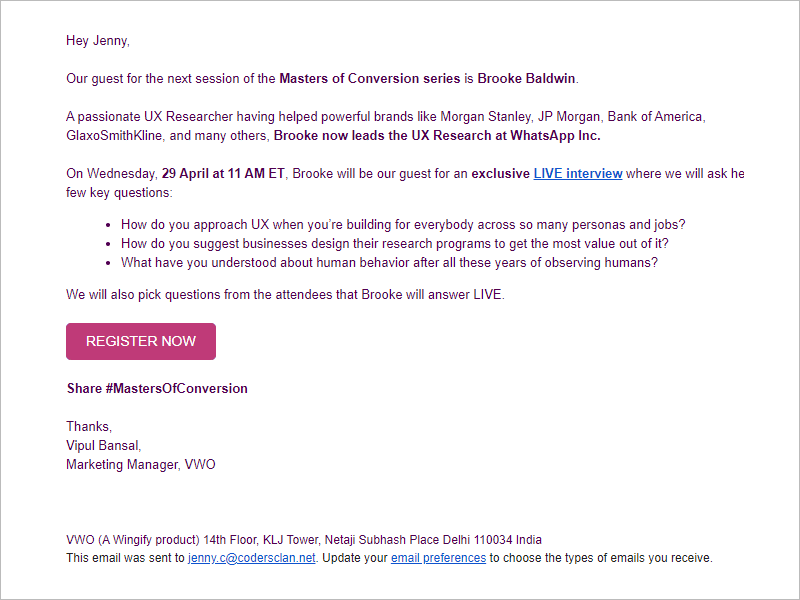
7. OptinMonster
OptinMonster is a conversion optimization tool for lead generation. It allows you to create beautiful attention grabbing optin forms that convert well.
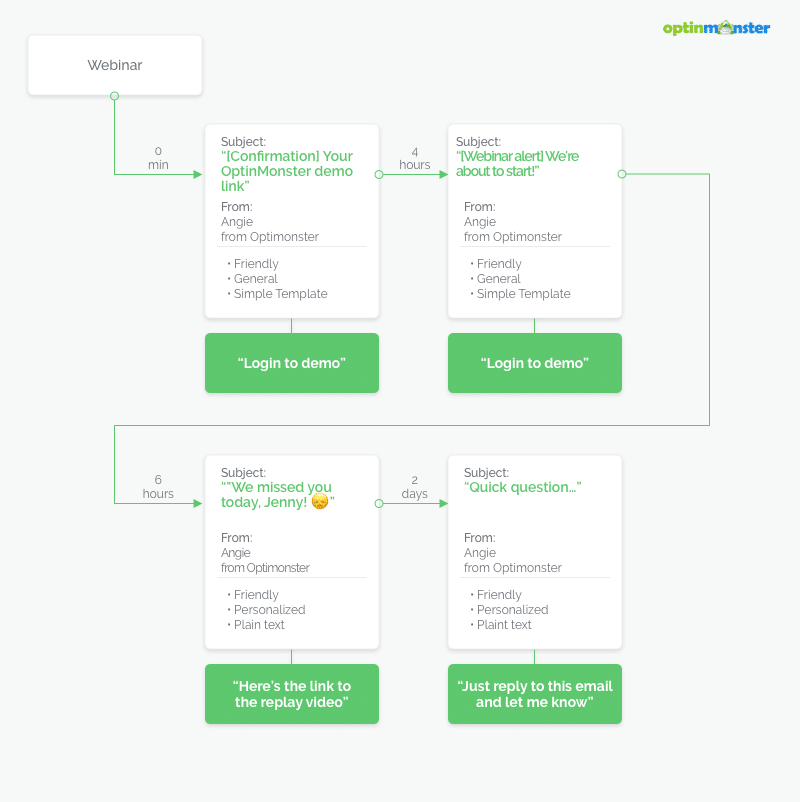
Sending a recording of a webinar is a great example of a very targeted follow up email based on user behavior – didn’t attend the webinar.
Sending a follow up after a webinar is a gold opportunity – especially if you personalize it to the user.
Note how the replay is a “limited” offer, together with the 20%, the fear of losing something is a very powerful tool to get people moving.
Another “trick” you can use in webinars is offering an exclusive price before the webinar and announcing the winner in a landing page, getting everyone engaged with an option to view the recording and take the next step.
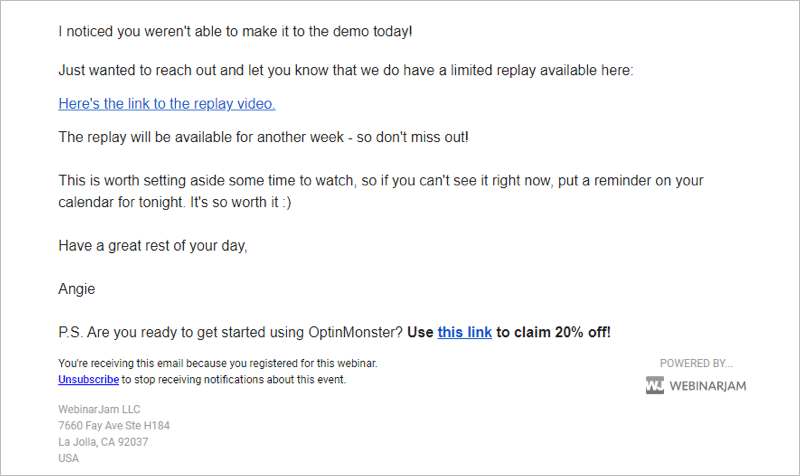
8. SalesForce
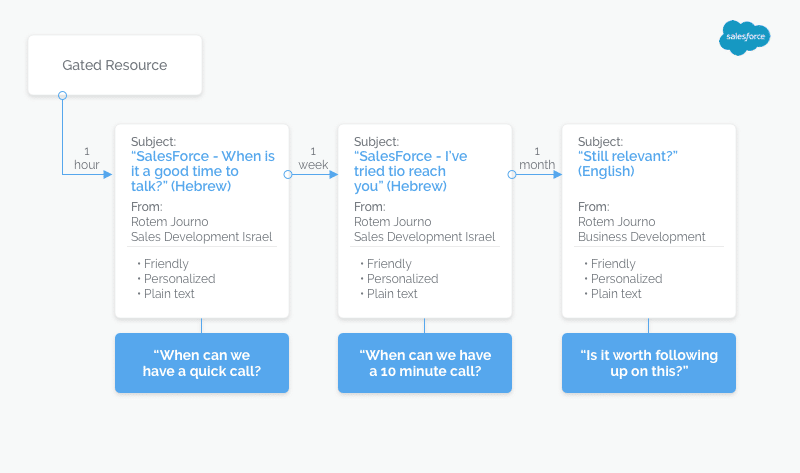
Emails 1 & 2
The combination of personalization and localization in the first 2 emails – approaching me in Hebrew, my local language, made it feel like those responses were sent by a real person. This can be explained by seeing the leads generated from gated resources as ones with a higher conversion rate. Therefore, the responses to those leads might actually be written in person by the local sales representative.
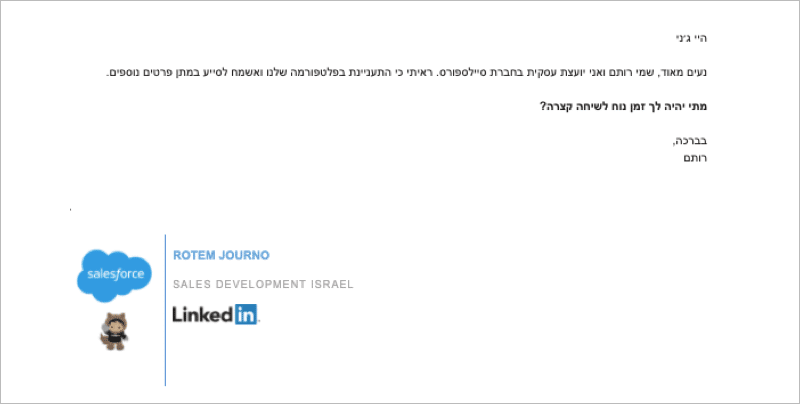
Email #3
The third email was in English. It was also sent from Rotem, but her title was different “Business Development” – not “Sales Development Israel”. In addition, this email had a different layout with a different signature. This implies that this email was sent automatically.
There is a great tactic I read in the book “Never split the difference” by Chris Voss for a last chance email to get people return your email:
Simply ask them if they’ve given up. The urge to reply with “of course not” is really strong.
“Have you given up on doing X?” can push almost any one to reply.
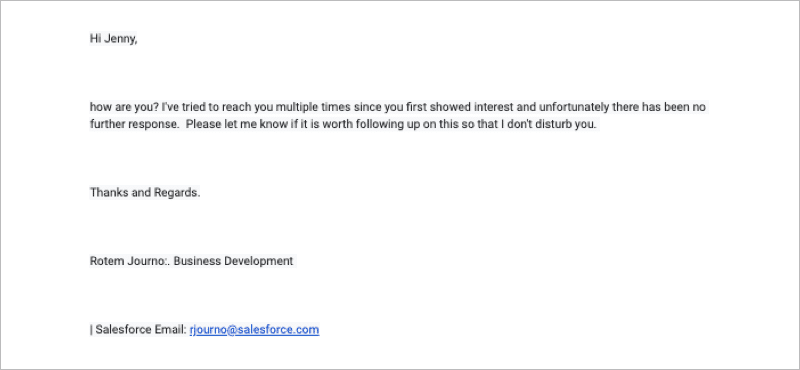
9. Intercom
Intercom is a business messenger to drive growth at every stage of the customer lifecycle.
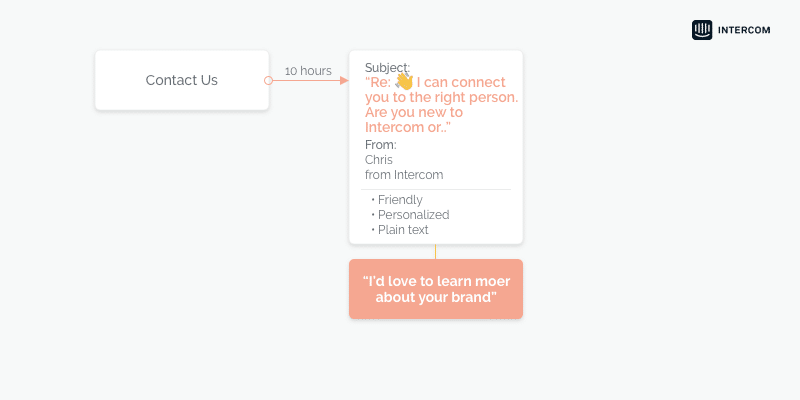
A different type of nurturing was done here, this email demonstrates how Intercom integrates the messages from the chatbot on their website into a thread and moves the conversation from the chatbot back to email if a customer has left the chat.
Note the emoji – emojis can make any email more personal and friendly (don’t abuse them though).
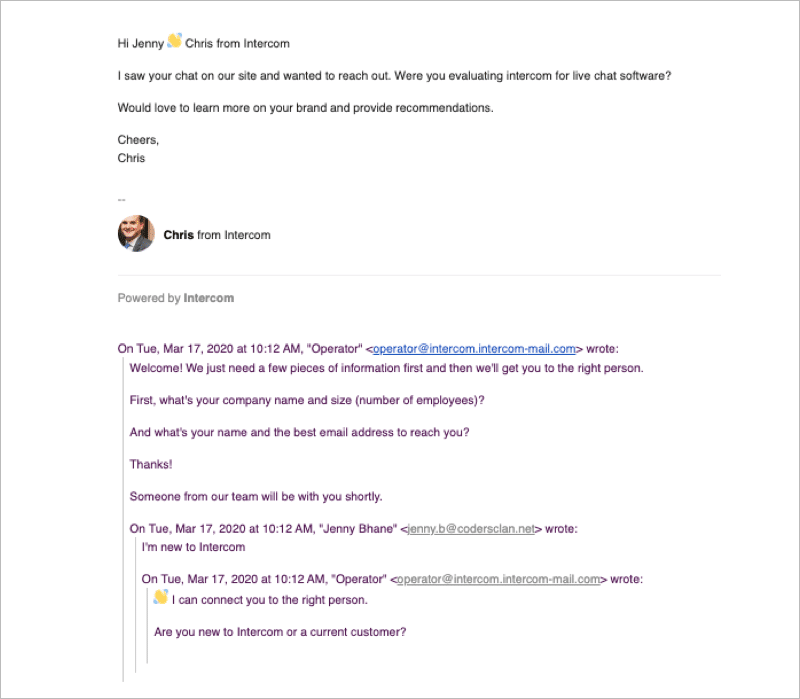
10. Outbrain
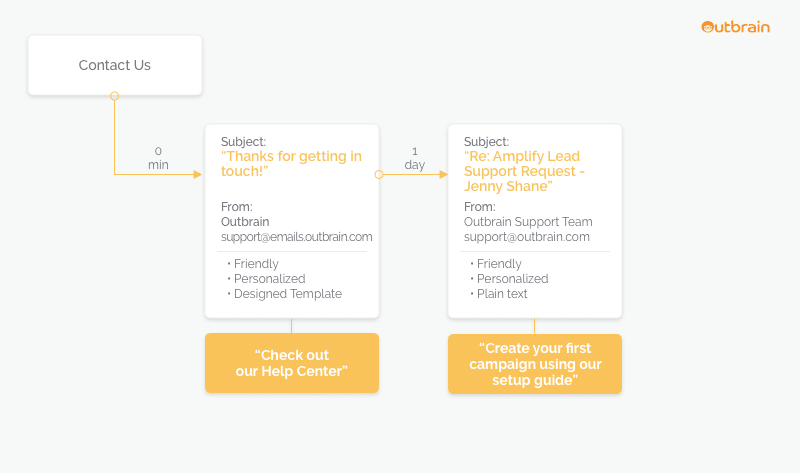
Probably due to the industry or the company email, Outbrain decided to use a generic product onboarding email.
Looks like the strategy here is to get the user to start using the platform as fast as possible rather than starting by sharing marketerial content.
This approach could probably work best for pay as you go, no risk, low charge products. Instead of explaining how great your product is, just let the users use it.
The general signature though shows there’s no real person behind the email, maybe aiming to reduce back and forth.
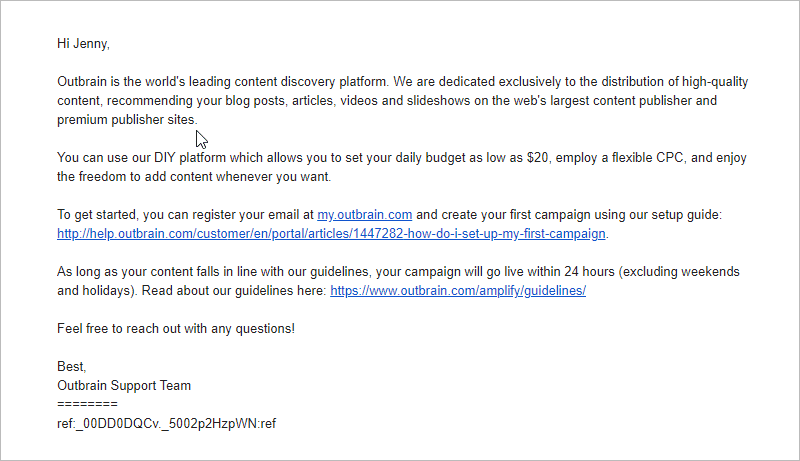
11. Optimizely
Optimizely is an experimentation platform, enabling businesses to deliver continuous experimentation and personalization across websites, mobile apps and connected devices.
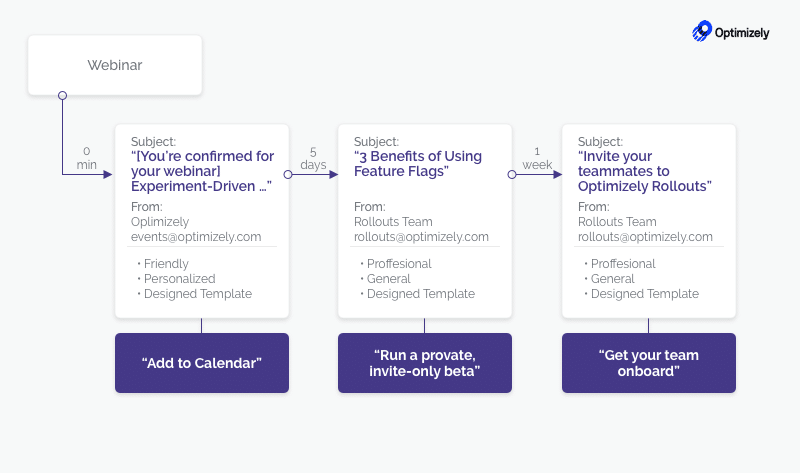
Use plain text in personalized emails that are sent from a specific contact.
For company announcements and resources, use designed templates that are consistent with your brand. The design in this confirmation email is simple, clean & clear. Looks very consistent to their website as well. We loved it.
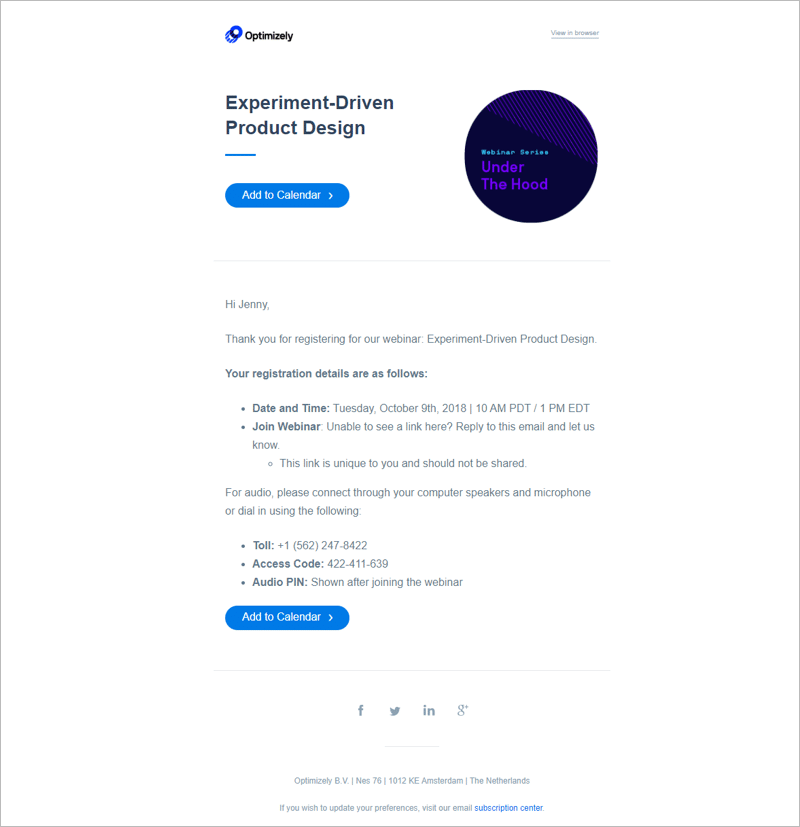
12. Proof
Proof lets you personalize your website for visitors, prospects and customers.
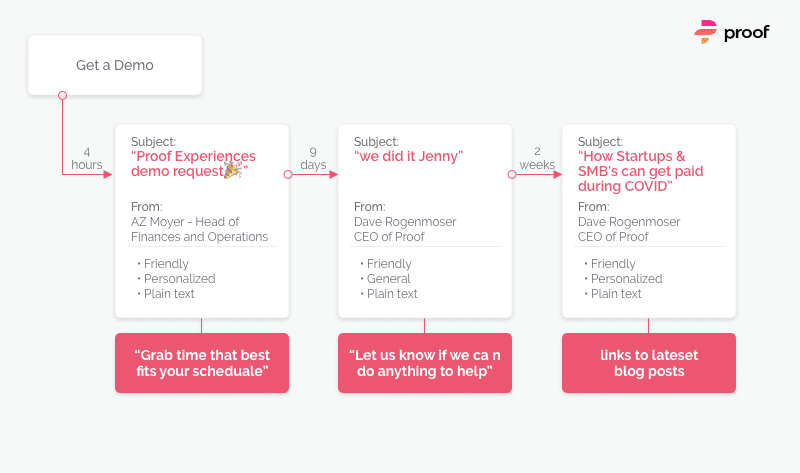
It was great receiving this email from Dave Rogenmoser, the CEO of Proof, addressing the COVID-19 situation and sharing their favorite tips to help us in those days.
Although it’s clear that this email was sent to the masses and not part of the nurturing campaign (probably to the entire mailing list), still, it felt very personal and the content was fun and refreshing.
Empathy and authenticity are a great way to get people to relate with you and your brand.
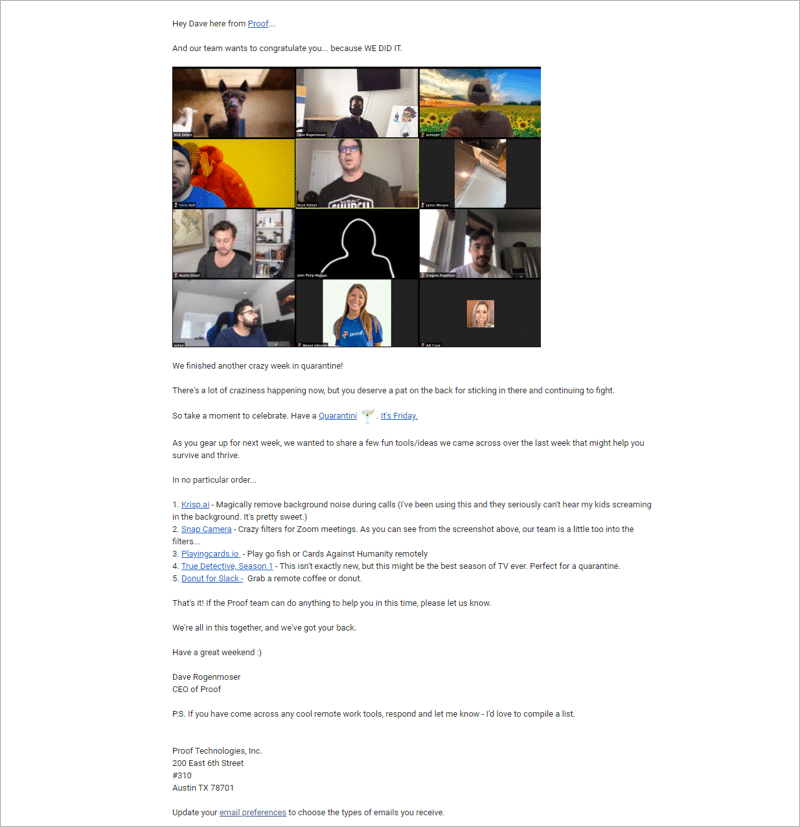
First timer doing nurturing campaigns?
Check out these great tips coming from top marketing experts:
“Start by creating a diagram to map the process and set a clear goal for each email. The main messaging in every email should be – the value that you provide for your customer, and the mindset should always be “you” and not “us”. The nuances of using the second person rather than the first person is extremely important to the success of your nurturing campaign.“
– Guido Senderowitsch | User Engagement Lead @ Taboola
“When you’re creating your email content, you don’t want to sound like a robot. Talk to your leads like a person and create a relationship with them. By referring to other sites and providing relevant information, you’re showing them that you’re here for them, and not just to meet your own needs. This will help you build trust, which is the most important step for leads at the top of the funnel.”
– Bonnie Seaman | Marketing Operations Manager @ AppsFlyer
“Even though you might have a vision for your end goal. You can’t get to your final version without going through your first iteration, second iteration etc. Define specific parameters to set up the nurture. For example: If someone is at the top of the funnel, and that’s their title, and that’s the industry they work in, then this is the eBook they need and they need it after they’ve been on the website 3 times. The magic formula is planning out to have the right content going to the right people at the right time.”
– Matilda Miglio | Marketing Manager @ Drift
The takeaways?
Copy. Value. Personalization.
Whether you are just starting or nurturing for years now – keep in mind the goal isn’t to send the email, but to provide value.
Use personalized emails by heavily segmenting your audience, being relevant and striving for conversations.
Set up goals, including KPIs, and if you really want to go pro, always be A/B testing.
